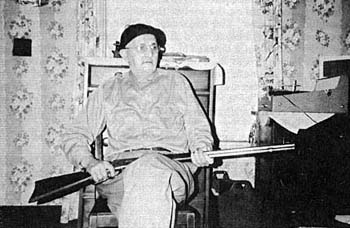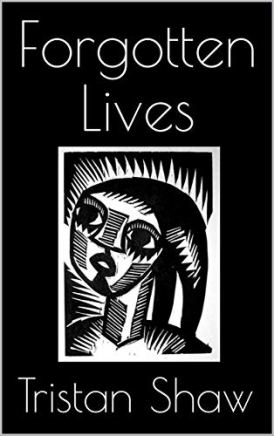
Fred Beck, veteran of America’s most horrific Bigfoot battle
As far as I can tell, Washington’s Ape Canyon is a gorge on Mount St. Helens that is neither shaped like an ape nor inhabited by one. The odd name comes from an incident reported in July 1924, when five miners claimed that they were attacked by a group of apemen. The story goes that a member of the mining party, a man named Fred Beck, took a shot at one of the creatures after being spooked. Later that night, the monsters appeared at the miners’ cabin, tossing boulders and rushing the door to break it down.
According to The Oregonian, the first paper to break the story, the apemen were covered in long black hair. They stood at 7 feet, weighed over 400 pounds, and possessed great strength. At one point, they made a hole in the cabin’s roof and dropped a rock inside, knocking Beck in the head. Despite the apemen’s mastery of rock-throwing, the gun-toting miners were able to hold their ground. By the morning, the creatures had retreated, allowing Beck and the other humans to run out the log-fort and return to civilization.
Yes, the miners’ tale was likely just a campfire yarn, but how could newspapers resist a showdown between giant apes and gold prospectors? At a time when the word “Bigfoot” hadn’t been coined yet, people referred to the miners’ violent apemen as “mountain devils” and “gorillas.” As word of the ambush spread, the story also became increasingly outlandish. A skeptical mention in the Engineering and Mining Journal put the number of combatants involved at “more than twenty animals,” while one Native American editor tied the apemen to the Seeahtik, a mythical tribe who used hypnotism to hunt for their game.
Although the Washington media’s interest in the Bigfoot assault eventually faded, the gorge where it happened was christened “Ape Canyon,” ensuring that the battle remained a part of local folklore. After the modern conception of Sasquatch took off in the late 1950s, researchers like journalist Betty Allen rediscovered the Ape Canyon incident and incorporated it into Bigfoot mythology. Probably encouraged by this new Bigfoot mania, Fred Beck sat down with his son Roland to create a memoir of the failed 1924 siege, titling his 1967 booklet “I Fought the Ape Men of Mt. St. Helens.”
Despite the long passage of time, Beck remembered the greatest Bigfoot brawl of the century rather well. Before that fateful day in July, Beck and the other miners had already come across large, unfamiliar tracks. The week of the incident, they heard whistling outside every evening, as though two creatures were trying to communicate with one another. During his description of the attack in the booklet’s first chapter, Beck clarifies a couple details that were misreported in the press. It was actually his friend “Hank” (a pseudonym) who shot the first apeman, for example, and it wasn’t true that Beck was hit in the head by a rock.
At most, Beck and his mining party saw only three apemen at a time, although there might have been more. When things quieted down in the morning, the miners came out of their cabin, and Beck spotted one of the creatures standing near a cliff. He shot it three times, sending the damn dirty ape over the edge, down to a fall that was four hundred feet below. After fleeing to a park ranger station at Spirit Lake, Beck wanted to keep the whole ordeal a secret, but “Hank” couldn’t keep his mouth shut. The story spread, journalists requested interviews, and curiosity-seekers and law officers scoured the area for signs of the attackers.
In the second chapter of the booklet, Beck reprints a 1964 news article about the Mt. St. Helen apemen, mentioning his own incident and the 1950 disappearance of a skier on the mountain. Further on, he admits to having been clairvoyant since childhood, noting a history of “visions” and “spiritual meetings.” Because a psychic element just wasn’t enough, Beck completely twists his story and speculates that the apemen were beings from a lower plane of existence. As a lost link between humans and their ancestors, the apemen sometimes manifested into our own dimension, anxious to ascend their petty state. They are curious, largely harmless critters, and are only searching for a higher consciousness.
This spiritual gobbledygook, although not entirely unwelcome for entertainment purposes, is entirely absent from the original ’20s reportage. There’s been debate over how much influence Roland had on his father’s written account, and even whether Fred Beck could remember the story as accurately as he thought he did. In terms of more practical solutions, a logger named Rant Mullins admitted in 1982 that he rolled rocks onto a cabin in the Mt. St. Helen area in 1924. Mullins had also faked giant footprints for decades, suggesting he was responsible for another important part of Beck’s “ambush.”
Another theory argues that the miners mistook a rock slide that hit their cabin for the monsters, and yet a third maintains that the assailants were teenagers from a local YMCA, who couldn’t be seen clearly due to the time of night. As for the Bigfoot that Beck shot and sent down into oblivion, this was either the case of an overactive imagination, or the brutal assassination of an innocent apeman attempting to reach a higher consciousness. Personally, I don’t believe in Sasquatch or its cousins, so I’m going to opt for the former explanation.
If you enjoyed reading this article, please consider supporting my work by buying my book “Forgotten Lives” on Amazon here. My first collection of short stories includes such sugary sweet tales as “The Society for the Preservation of Vice,” in which a group of decadent artists attempt to pull off a human sacrifice, and the heart-warming “A Gourmet’s Confession,” in which a glutton resorts to cannibalism after he can’t eat conventional food anymore. Although not appropriate for everyone, the book is a favorite among apemen, and has been a popular item to toss at miner cabins.

Pingback: Ape Canyon’s Weird 1924 Bigfoot Assault - KRIPTIQ
Pingback: The Disappearance of J.C. Brown, a Man Who Allegedly Found Lemurian Ruins | Bizarre and Grotesque
Pingback: The Hibagon: A Japanese Bigfoot That Might Also Be A Marketing Ploy | Bizarre and Grotesque
Pingback: The Hibagon: A Japanese Bigfoot That Might Also Be A Marketing Ploy • 10ztalk Crime
Thanks for your article on this. It was actually the Longview Daily News, dated July 12, 1924 that was the first to report on the incident.
LikeLike
Thanks for the tip! I’ll update the article soon.
LikeLike
Pingback: El Hibagon: un Bigfoot japonés que también podría ser una estratagema de marketing | Marcianitos Verdes
If you really want to have your mind blown by these guys then read the story where they followed a lady in white or multiple of them to find the mine as well as the Bigfoot and the lady in white are coupled together with orbs.. it’s out there but it’s one help of a read!
LikeLike
I simply stunned that, after all the evidence in recent years of the existence of bigfoot, you scoff at such a thought. There is more evidence these creatures exist than not. Educate yourself.
LikeLike